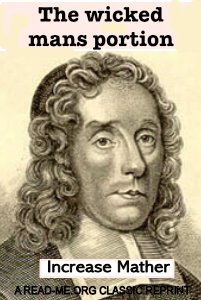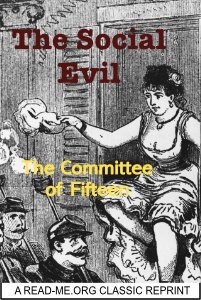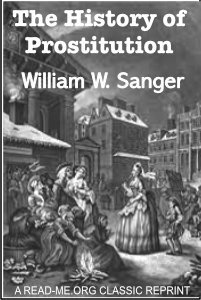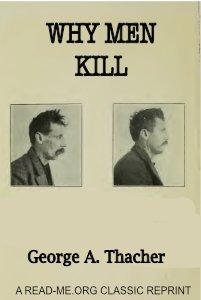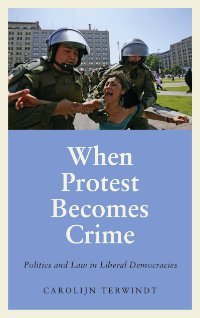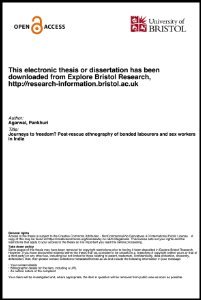By The Committee of Fifteen
With special reference to conditions existing in the city of New York. . “In the fall of 1900, the city of New York was startled by discoveries in regard to the spread of the Social Evil in certain districts, and as to the extent of flagrant offences against public morality and common decency. A meeting of citizens was held at the Chamber of Commerce in November, as a result of which the Committee of Fifteen was called into existence. The objects which the Committee of Fifteen undertook to accomplish were thereupon stated as follows : (1) To institute a searching inquiry, uninfluenced by partisan considerations, into the causes of the present alarming increase of gambling and the Social Evil in this city, and to collect such evidence as shall establish the connection between existing conditions and those who, in the last analysis, are responsible for these conditions. (2) To publish the results of such investigations in order to put our fellow-citizens in possession of facts, and to enable them to adopt such corrective measures as may be needed. (3) To promote such legislation as shall render it less difficult to reach offenders, and as shall put an end to the shifting and division of responsibility in the local administration of the laws relating to vice and crime, to the end that public officers and their subordinates may be held to a strict accountability for their acts. (4) To suggest and promote the provision of more wholesome conditions and surroundings, in order to lessen the allurements and incentives to vice and crime.”
New York: G.P. Putnam's Sons, 1902. 188p.
By William W. Sanger.
Its Extent, Causes and Effects Throughout the World. “The history of prostitution around the world from the earliest Egyptian Courtesans to those night houses or street vendors of the late to 19th century. Arguments are unnecessary to prove the existence of prostitution. The evil is so notorious that none can possibly gainsay it. But when its extent, its causes, or its effects are questioned, a remarkable degree of ignorance or carelessness is manifested. Few care to know the secret springs from which prostitution emanates; few are anxious to know how wide the stream ex tends; few have any desire to know the devastation it causes. Society has formally laid a prohibition on the subject, and he who presumes to argue that what affects one may injure all; he who believes that the malady in his neighbor's family to-day may visit his own to-morrow ; he who dares to intimate that a vice which has blighted the happiness of one parent, and ruined the character of one daughter, may produce, must inevitably produce, the same sad results in another circle ; in short, he who dares allude to the subject of prostitution in any other than a mysterious and whispered manner, must prepare to meet the frowns and censure of society.”
New York: The Medical Publishing Co., 1899. 709p.
By Andreas Bjerre.
A Study in Criminal Psychology. “The subject has attracted many writers before Bjerre—philosophers, doctors, lawyers and essayists. But Bjerre has approached the problem from an entirely new point of view. He has not contented himself with wide generalizations, or with the treatment of such second-hand material as criminal statistics, reports of trials, hospital and prison journals or other superficial data, however obtained He has devoted many years of his life to first-hand study in Swedish prisons in order by constant personal association with criminals to solve the riddles hidden away in the dark places of their psychic lives.” (Preface).
Longmans, Green and Co. ltd., 1927. 182p.
By George A. Thacher.
Murder Myusteries Revealed. “I did not feel confident that the list was entirely accurate, but I realized that every day association with the prisoners probably made the designation of defective by these men worthy of thoughtful consideration at least. In jotting down the names of these prisoners I asked what offenses they had committed. In this list approximating 70 defective prisoners 36 were serving sentences for rape and of the 36 there were 13 who had raped their own daughters. One prisoner was serving his third term for this same offense. Seventeen of these prisoners were guilty of the offense which has made ancient Sodom a byword through the centuries. Six of these men had committed murder and all of the six were sex perverts. Naturally these defective beings often have a defective moral sense. My observation has often confirmed that fact. Kraft Ebing remarks that this psychic degeneration, however, has a more profound pathological foundation, because often it can be referred to distinct cerebro-pathologic conditions, and often enough is associated with anatomic signs of degeneration.”
Portland, OR: Press of Pacific Coast Rescue and Protective Society, 1919. 121p.
By Carolijn Terwindt.
Politics and Law in Liberal Democracies.How does protest become criminalised? Applying an anthropological perspective to political and legal conflicts, Carolijn Terwindt urges us to critically question the underlying interests and logic of prosecuting protesters. The book draws upon ethnographic research in Chile, Spain, and the United States to trace prosecutorial narratives in three protracted contentious episodes in liberal democracies. Terwindt examines the conflict between Chilean landowners and the indigenous Mapuche people, the Spanish state and the Basque independence movement, and the United States' criminalisation of 'eco-terrorists.' Exploring how patterns and mechanisms of prosecutorial narrative emerge through distinct political, social and democratic contexts, Terwindt shines a light on how prosecutorial narratives in each episode changed significantly over time. Challenging the law and justice system and warning against relying on criminal law to deal with socio-political conflicts, Terwindt's observations have implications for a wide range of actors and constituencies, including social movement activists, scholars, and prosecutors.
London: Pluto Press, 2020. 305p.
Edited by Stefan Amirell, Hans Hägerdal, Bruce Buchan.
In a modern global historical context, scholars have often regarded piracy as an essentially European concept which was inappropriately applied by the expanding European powers to the rest of the world, mainly for the purpose of furthering colonial forms of domination in the economic, political, military, legal and cultural spheres. By contrast, this edited volume highlights the relevance of both European and non-European understandings of piracy to the development of global maritime security and freedom of navigation. It explores the significance of ‘legal posturing’ on the part of those accused of piracy, as well as the existence of non-European laws and regulations regarding piracy and related forms of maritime violence in the early modern era. The authors in Piracy in World History highlight cases from various parts of the early-modern world, thereby explaining piracy as a global phenomenon.
Amsterdam: Amsterdam University Press, 2021. 290p.
By Sytske Besemer.
The apple doesn't fall far from the tree', 'Like father like son', 'Chip off the old block'. All these idioms seem to suggest that offspring resemble their parents and this also applies to criminal behaviour. This dissertation investigates mechanisms that might explain why children with criminal parents have a higher risk of committing crime. Several explanations for this intergenerational transmission have been contrasted, such as social learning (imitation of behaviour), official bias against certain families, and transmission of risk factors. Sytske Besemer investigated this in England as well as in the Netherlands. She answers questions such as: does it matter when the parents committed crime in the child's life? Do more persistent offenders transmit crime more than sporadic offenders? Do violent offenders specifically transmit violent behaviour or general crime to their children? Might the police and courts be biased against certain families? Could a deprived environment explain why parents as well as children show criminal behaviour? Does parental imprisonment pose an extra risk? This dissertation is the first study to specifically investigate these mechanisms of intergenerational continuity. The study is scientifically relevant because of its breadth, integration of conviction data as well as data on self-reported offending and environmental risk factors, its comparative design and the long periods over which transmission is investigated. Furthermore, the dissertation has important policy implications. It demonstrates how penal policy designed to reduce criminal behaviour might actually increase this behaviour in the next generation. This is especially important since Western countries such as the United Kingdom and the Netherlands show an increasing trend towards more punitive policies.
Leiden: Sidestone Press, 2012. 198p.
By Pankhuri Agarwal.
Working with a simplistic notion of release from bondage as “freedom”, mainstream anti-trafficking activists focus on rescue. They argue that victims of trafficking are “free” once removed from their employers. Critics contest this approach and argue that significantly less attention is paid to the role of the state and the NGOs in producing conditions due to which people remain vulnerable. This research lends empirical support to this critical position through a multi-sited ethnography of informal migrant workers, sex workers, and law enforcement officers, traversing through courtrooms, police stations, district welfare offices, worksites, shelter homes, and offices of NGOs, in New Delhi, India. It corroborates that the authority of law is compromised ‘on ground’ and is actively negotiated within the legal space of anti-trafficking efforts. Instead of being instantly transported to “freedom”, the workers end up in protracted legal proceedings, ranging two to thirty-seven years, to seek justice and rights. Their rights are neglected due to a Kafkaesque bureaucracy. Their mobility is restricted due to improper documentation. Their suffering is intensified through an evasive legal system. The result – arbitrary, unjust legal outcomes after an endless wait and dependence on intermediaries. In fact, their journey through the system, with cost and time overruns, has no direct or precise chronology, and often moves in a circle rather than reaching an end. The workers resemble the class of people that Denise Ferreira da Silva (2009) describes as “nobodies”. They continue to struggle to achieve the rights and recognition that would allow them to escape this status. The combination of empirical data, doctrinal analysis, and socio-legal theory in this research provide an insight on the harm and limits of the anti-trafficking discourse with reference to India.
Bristol, UK: University of Bristol, 2021. 233p.
By Elizabeth T. Hurren.
In this discipline-redefining book, Elizabeth T. Hurren maps the post-mortem journeys of bodies, body parts, organs and brains, inside the secretive culture of modern British medical research after WWII as the bodies of the deceased were harvested as bio-commons. Often the human stories behind these bodies were dissected, discarded or destroyed in death. Hidden Histories of the Dead recovers human faces and supply-lines in the archives that medical science neglected to acknowledge. It investigates the medical ethics of organ donation, the legal ambiguities of a lack of fully informed consent and the shifting boundaries of life and re-defining of medical death in a biotechnological era. Hurren reveals the implicit, explicit and missed body disputes that took second place to the economics of the national and international com modification of human material in global medical sciences of the Genome era. This title is also available as open access.
Cambridge University Press. (2021) 350 pages.


